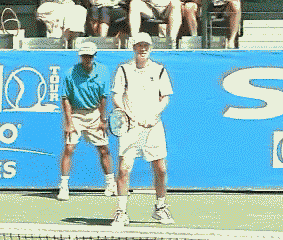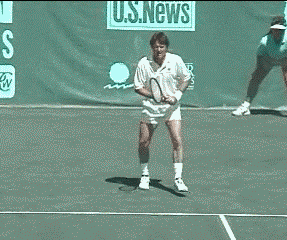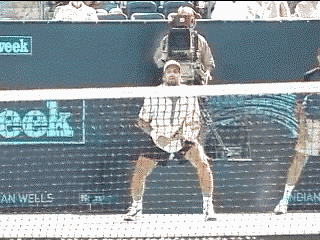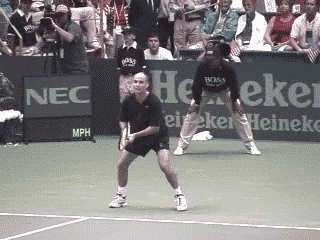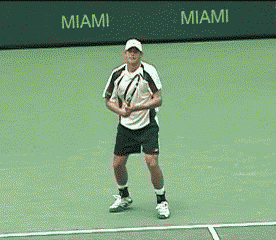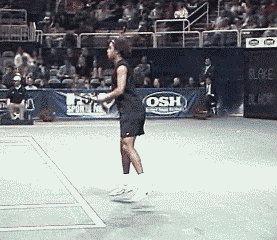|
TennisOne Lessons The Return of Serve Simplify, Borrow Pace, Get the Ball in Play Jim McLennan
In spite of one's forehand, conditioning, nutrition, or mental toughness, according to the old saw, "You are only as good as your second serve." In the recent men's final at the US Open, Roger Federer won 50% of the points played on his second serve. Andy Roddick managed to win only 39% of the points played on his second serve. And in the final analysis the entire match may have hinged one this single disparity. On big points and against big servers, Federer simply and reliably just blocked the ball, neutralized the serve and then looked to take control of the point. Nothing big, nothing fancy, just one more return, one more opportunity to get the ball in play, and one more opportunity for the opponent to err (as Roddick did on multiple occasions at 5-6 in the third against relatively neutral returns). But, if one is only as good as one's second serve (and this includes confidence, placement, speed and disguise), it follows equally that one is only as good as their return of serve. And I believe this is an area of opportunity for both James Blake and Andy Roddick, and equally, an opportunity for you and I. Return of serve, keep it simple, get the ball in play, construct the point within the ensuing rally. Lets take a closer look.
Comparing the style of play from the 1970's and 1980's to the game played today, provides a useful insight into the return of serve. Jimmy Connors and John McEnroe both returned serve superbly. Consistent and forcing, they took the ball early. Jimbo on the baseline, Mac dashing to the net, both used short simple strokes, taking pace from the incoming ball rather than clubbing winners. There were big servers in those days (obviously not as big as today) but the winning records of Jimbo and Mac had as much to do with their return of serve, as it did about their tactical acumen (Jimbo) and serve and volley skills (Mac). As a player or an observer, it can be easy to overlook simplicity and more readily notice all the power in the modern game. Everybody recalls the "big shots" that occurred in a match rather than the flood of routine errors. Somehow in the end, too often we don't fully appreciate how simply one can return the ball and how that can lead to big results.
In the modern game swings are truly more forceful, the spin more vigorous, and "racquet head speed" rather than "blocking" is the name of the game. Certainly the bigger and faster swings of James Blake and Andy Roddick do appear much different than the simpler styles of Connors and McEnroe. And though there is no turning the clock back, I believe the games you and I play are closer in speed and tempo to the previous era, but unfortunately we approach this game with modern tools. But at the end of the day, there is a way to refocus on the return of serve, simplify the stroke, borrow the incoming pace, and dominate an opponent with steady, consistent and unerring returns. Incoming Pace When volleying, the incoming ball has not bounced, it has retained most of its original momentum, such that volley strokes generally deflect the ball, and "borrow" or use the incoming pace for the resulting collision. Volley strokes are short and firm, not long and flowing, and not loose (and interestingly many of our renown volleyers including Edberg and Rafter used similarly short and firm strokes when returning serve). Conversely, when serving the ball has no incoming momentum so in this case one creates as much racquet speed as possible, with generally a long, flowing, and loose swing. The ground strokes fall somewhere in between. If the incoming ball is traveling at say 60 mph, one can decide whether to borrow or add pace, depending on court position and the difficulty of the incoming ball.
But notwithstanding the rocket like returns of Andre Agassi (see below), I believe that when receiving a serve of 80 mph or even 100 mph players who borrow pace are far more consistent, more accurate and more confident than those who add pace and swing forcefully at the incoming serve. And what worked for Jimbo and Mac will work in spades for you and I. But first one must get the idea and then the feel for "borrowing" rather than "adding." Note - Andre Agassi had a great return of serve, which made the Sampras Agassi rivalry so compelling, the greatest server vs. the greatest returner. Within the model of turning early, shortening the stroke, and making simple contact, Agassi was as good as anyone. But to my mind Agassi's skills were as much about his technique as about his talent and uncanny timing. However, this great timing and talent often led him to add pace, to wallop the return, and for the purposes of this article I am pursuing a line of thought about borrowing pace because few, if any, of us possess the magical skills of Andre Agassi. Forehand Variations The first reaction to an incoming ball, whether forehand or backhand, is to turn to the side. Turn as quickly as possible, a pivot to the forehand or backhand side, and with this turn, the racquet moves to the side, facing the net, more or less waiting in the contact zone. I am fairly stubborn about this - preparation is not about taking the racquet back, preparation is not about shuffling to the ball, preparation is first and foremost turning to one side or the other. The remainder of the stroke flows from this first move, and in the case of the forehand, there are two distinct variants as regards the elbow. In the modern power game, the elbow moves up and away from the body, leading to a large circular swing. Racquet speed, pace, and spin flow from this power move. In plan B (the previous era) the elbow hangs at the side in the vicinity of the ribs. This is more a control move than a power move, the intent is to align the racquet to the incoming ball in order to meet rather than crush the ball.
Personal Checkpoints There is a simple way to evaluate your preparation when returning serve. Monitor (meaning closely evaluate with extreme physical awareness) your positioning when the incoming serve has hit the top of the net (in other words, the serve is a fault). Ideally, when the ball strikes the net, you should be turned to one side or the other, balanced on the back foot, with relatively good posture. But if the ball would have been a forehand (had it not hit the net), note your elbow, is it tucked comfortably at your side (the simple old school method) or well back and up (the modern power method)? On the serve the ball flies from racquet to racquet in one to one and one half seconds. If you are trying to prepare early, you should accomplish your opening turn by the time the ball reaches the net. However, equally as important as turning quickly, is the act of simplifying the racquet movement. Plan B - Old School Try the following, either on the ball machine, on drop hits, or with a friend feeding balls. Place a ball lightly between your elbow and ribs. Turn to the forehand side, stroke the ball, and note if and when the ball between your elbow and ribs falls to the ground. If it falls on the backswing, it shows your elbow was flying up and away (modern and or overdone). If it never falls, it indicates the backswing was simple but the finish cramped. The object is to make contact and then allow this ball to fall on the follow through. Truly, Mac and Jimbo's forehand returns appeared this simple, not much of a backswing, but with careful extension on the follow through. At the end of the day, tennis is a game of errors, and no matter how many winners you or I or the amazing Roger Federer can hit, it is usually errors that rule the day. With the advent of more powerful racquets, as well as the crop of more powerful players on the pro tour, we may lose sight of the simple adage, "get the ball in play." The easiest way to break serve, whether in singles or doubles, is first and foremost to make all of one's returns. Your comments are welcome. Let us know what you think about Jim McLennan's article by emailing us here at TennisOne.
|
||||||||||||||

